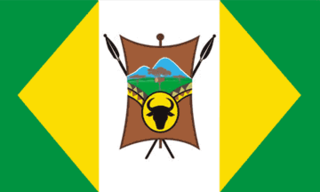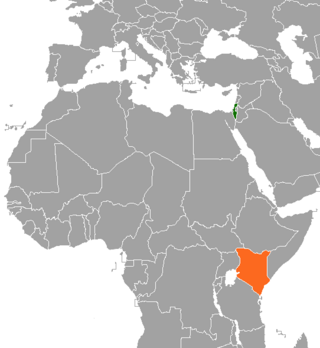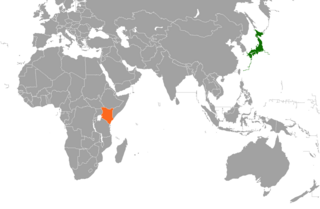
Kenya, officially the Republic of Kenya, is a country in East Africa. With a population of more than 47.6 million in the 2019 census, Kenya is the 28th-most-populous country in the world and 7th most populous in Africa. Kenya's capital and largest city is Nairobi, while its oldest and second-largest city, is the major port city of Mombasa, situated on Mombasa Island in the Indian Ocean and the surrounding mainland. Mombasa was the capital of the British East Africa Protectorate, which included most of what is now Kenya and southwestern Somalia, from 1889 to 1907. Other important cities include Kisumu and Nakuru. Kenya is bordered by South Sudan to the northwest, Ethiopia to the north, Somalia to the east, Uganda to the west, Tanzania to the south, and the Indian Ocean to the southeast. Kenya's geography, climate and population vary widely, ranging from cold snow-capped mountaintops with vast surrounding forests, wildlife and fertile agricultural regions to temperate climates in western and rift valley counties and further on to dry less fertile arid and semi-arid areas and absolute deserts.
An office of emergency management (OEM) is a local, municipal, tribal, state, federal/national, or international organization responsible for: planning for, responding to, and dealing with recovery efforts related to natural, manmade, technological, or otherwise hazardous disasters by planning and implementing large scale emergency response plans/procedures, coordinating emergency assets during a disaster, and providing logistical, administrative and financial support to a disaster response effort.

Ndoc Martini was an Albanian painter.

The National Assembly of the Republic of Kenya is one of the two Houses of the Parliament of Kenya. Between 1966 and 2013, it served as a unicameral house. In 2013, it became the lower house when the Senate was reestablished.
Sandcastle is a documentation generator from Microsoft. It automatically produces MSDN-style code documentation out of reflection information of .NET assemblies and XML documentation comments found in the source code of these assemblies. It can also be used to produce user documentation from Microsoft Assistance Markup Language (MAML) with the same look and feel as reference documentation.

NDoc is a code documentation generator for the Common Language Infrastructure created by Jason Diamond, Jean-Claude Manoli and Kral Ferch. It is licensed under the GNU General Public License.

West Pokot County is a county in Kenya. Its capital and largest town is Kapenguria. The county covers an area of approximately 9,169.4 square kilometers and stretches a distance of 132 kilometers from north to south.

Ely State Prison (ESP) is a maximum security penitentiary located in unincorporated White Pine County, Nevada, about 9 miles (14 km) north of Ely. The facility, operated by the Nevada Department of Corrections, opened in July 1989. As of 2010, the prison has a staff of 406 and is a major employer in the Ely area. As of September 2010, the prison housed 1,077 male inmates.

Rugby union in Uganda has been played since colonial times when it was introduced by the British. The governing body is the Uganda Rugby Football Union.

Israel–Kenya relations are foreign relations between Israel and Kenya. The countries established diplomatic relations in December 1963. Israel has an embassy in Nairobi. Kenya has an embassy in Tel Aviv.

HelpNDoc is a Windows-based help authoring tool published by French company IBE Software.
The Florence McClure Women's Correctional Center is a state prison for women in North Las Vegas, Nevada, United States. All custody levels are housed there. It is operated by the Nevada Department of Corrections (NDOC). It houses Nevada's female death row.
Masii is a small town in Kenya's Machakos County, Kenya. Myth has it that the settlent got it's name from Storkbirds (Ngoto). It was narrated that Masii used to be inhibited by a certain tree Itungi which bears fruits that were a delicacy for immigrating birds. Masii was their home when escaping winter in Europe. When humans settled in Masii they cut the Itungi tree to the detriment of the immigrating birds. When the time to land in Masii came the birds found their paradise destroyed and they left wailing thina twooneie masii sii sii and thus was the birth of the name of the settlement. It also marked their birth of a saying, warning people against disaster – "be careful not to experience what Ngoto (storkbird) experienced in Masii". The majority of the people living in Masii come from the akamba community. Swahili and Kamba are the most Common languages in the area.

Ndoc Gjetja was an Albanian poet.
The Nevada Department of Corrections is a governmental agency in the U.S. state of Nevada.
The 2011 Nairobi pipeline fire was caused by an explosion secondary to a fuel spill in the Kenyan capital Nairobi on 12 September 2011. Approximately 100 people were killed in the fire and at least 116 others were hospitalized with varying degrees of burns. The incident was not the first such pipeline accident in Kenya, with the Molo fire of 2009 resulting in at least 133 fatalities and hundreds more injured.

Kenyan–Japanese relations are bilateral relations between Kenya and Japan.

The Kenya Indian Congress (KIC) was a political party in Kenya.
The Peza Conference was held in Pezë, a village near Tirana in Albania, on September 16, 1942. The conference's goal and objective was to organize different political forces in the resistance against Italian rule. Later, this organization was named the National Liberation Movement.
The Patel Milmet Dam was a privately owned embankment dam located near the township of Solai, Nakuru County, in Kenya's Rift Valley. The dam burst amid heavy rains on 9 May 2018, killing at least 48 people.










